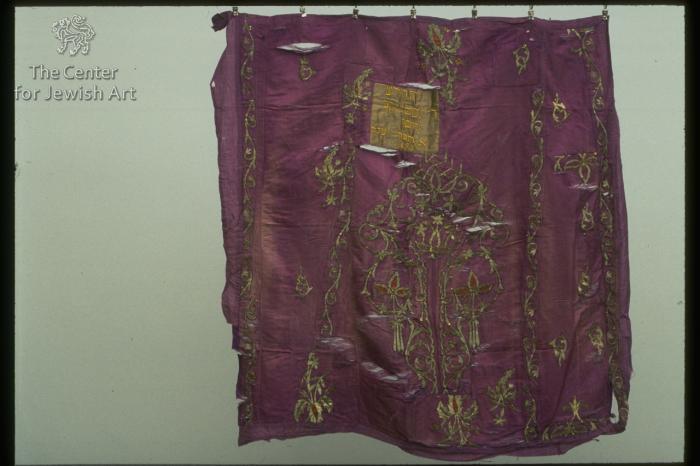Img. ID: 12980

The rectangular fragment of a parokhet consists of a main cloth with a lining (see: Remarks: no. 1). The central upper part is decorated with foliate-scrolled branches emerging from three vases and creating a leaf-shaped motif. Curved foliate branches and various floral motifs are scattered all around. An additional gray tiny square piece of cloth with a dedicatory inscription is attached to the parokhet (fig. 1). The Hebrew inscription embroidered in square filled letters reads:
"הקדש/ ר' ניסים יעקב/ רוסו/ א' תשרי שנה/ 5692."
“A Dedication (made by) Rabbi Nissim Jacob Russo at the first of Tishrei 5692 (New Year 12.9.1931).”
Online collection of the ritual objects from the E. Ringelblum Jewish Historical Institute is available here: http://cbj.jhi.pl/collections/964689
Name/Title
Parokhet | *Synagogue Objects | Torah ark | Torah ark curtain (Parokhet)
Object
Object Detail
Settings
Unknown
Date
1931
Synagogue active dates
Reconstruction dates
Artist/ Maker
Unknown (Unknown)
Origin
Historical Origin
Unknown
Community type
Congregation
Unknown
Location
Unknown |
Site
Unknown
School/Style
Period
Unknown
Period Detail
Collection
Documentation / Research project
Unknown
Category
Material / Technique
Silk, cotton and metal
Material Stucture
Material Decoration
gold threads in laid and couched embroidery, Foundation: cardboard
Material Bonding
Material Inscription
gold threads in laid and couched embroidery, Foundation: cardboard
Material Additions
fringed strip of wound gold and silver threads, paillettes
Material Cloth
silk purple satin
Material Lining
cotton uneven twill
Tesserae Arrangement
Density
Colors
Construction material
Measurements
Height
960 mm
Length
Width
910 mm
Depth
Circumference
Thickness
Diameter
Weight
Axis
Panel Measurements
Subject
Unknown |
Condition
The fragment is in bad condition.
Extant
Documented by CJA
Surveyed by CJA
Present Usage
Present Usage Details
Condition of Building Fabric
Architectural Significance type
Historical significance: Event/Period
Historical significance: Collective Memory/Folklore
Historical significance: Person
Architectural Significance: Style
Architectural Significance: Artistic Decoration
Urban significance
Significance Rating
Textual Content
Unknown |
Languages of inscription
Unknown
Shape / Form
Unknown
0
Ornamentation
Custom
Contents
Codicology
Scribes
Script
Number of Lines
Ruling
Pricking
Quires
Catchwords
Hebrew Numeration
Blank Leaves
Direction/Location
Façade (main)
Endivances
Location of Torah Ark
Location of Apse
Location of Niche
Location of Reader's Desk
Location of Platform
Temp: Architecture Axis
Arrangement of Seats
Location of Women's Section
Direction Prayer
Direction Toward Jerusalem
Coin
Coin Series
Coin Ruler
Coin Year
Denomination
Signature
Colophon
Scribal Notes
Watermark
Hallmark
Group
Group
Group
Group
Group
Trade Mark
Binding
Decoration Program
Summary and Remarks
1. The fragment of the parokhet is a secondary use of a wedding dress, which was adjusted to be a rectangular Torah Ark curtain.
Remarks
Suggested Reconsdivuction
History/Provenance
A collection of ritual objects was confiscated from the Greek Jews when they were sent to Auschwitz during World War II. This parokhet was transferred in 1948 to the museum from Narozno, a city in Silesia where the Nazis stored the objects.
Main Surveys & Excavations
Bibliography
- Juhasz, Esther. “The Material Culture of Sephardic Jews in the Western Ottoman Empire (Nineteenth and Twentieth Centuries),” In The Jews of the Ottoman Empire. Edited by Avigdor Levy, 575-583. Princeton: The Institute of Turkish Studies, 1994.
- Juhasz, Esther. “Arigim ve-rekamot ba-bayit u-ve-veit ha-keneset.” In Yehudei Sepharad Ba-Imperia Ha-Ottomanit. Ed. by Esther Juhasz, 64-119. Jerusalem: The Israel Museum, 1989. In Hebrew.
Short Name
Full Name
Volume
Page
Type
Documenter
|
Author of description
|
Architectural Drawings
|
Computer Reconstruction
|
Section Head
|
Language Editor
|
Donor
|
Object Copyright
The Emanuel Ringelblum Jewish Historical Institute in Warsaw (JHI)
Negative/Photo. No.



